A Naive Bayesian Wind Power Interval Prediction Approach Based on Rough Set Attribute Reduction and Weight Optimization
Abstract
1. Introduction
2. Proposed Approach for Forecasting Wind Power Intervals and General theory
2.1. Basic Theory of Rough Sets
2.2. Naive Bayesian Classifier
2.3. The PSO Algorithm
3. Establishing the RS-PSO-NBC Wind Power Intervals Model
3.1. Rough Set Selects Criteria Attribute
- (1)
- Establish a decision table. For a sample , the wind speed ; ; , the power of ; ; ; and are taken as original condition attributes, , . Wind power output is selected as the decision attribute . One element of universe can be defined as ,
- (2)
- Discretize the decision tables. Rough sets can only deal with discrete information, so the decision table needs to be discretized. In this paper, an equidistant interval algorithm is used. According to the maximum and minimum values for wind power, the value interval of is divided into 20 discrete intervals, and the values falling in each interval are equal to 1, 2, 3, ..., 20 respectively. is also discretized according to the maximum and minimum values of the wind speed.
- (3)
- Calculate the attribute significance of each condition attribute and determine the input for NBC.
3.2. The Naive Bayesian Classifer Infers the Power Class
3.3. PSO Optimizes Output Weight
3.3.1. Optimizing the Objective Function
3.3.2. Weight optimization by PSO
- (1)
- Initialize the particle swarm, via random initialization of the particles.
- (2)
- Calculate the fitness of each particle according to the objective function F, as shown in (13).
- (3)
- For each particle, its fitness is compared with its historical optimum fitness, and if the current fitness is better, that fitness is denoted as the historical optimum value.
- (4)
- For each particle, compare its fitness and the fitness of the best position experienced by the swarm; if better, it is optimal as a swarm.
- (5)
- The velocity and position of the particle are evolved according to the velocity and position update Equations (9)–(10).
- (6)
- If the end condition is reached (an optimal solution or the maximum number of iterations), then the swarm optimal position is the optimal output weight , otherwise go to step (2).
3.4. The Prediction Process
- (1)
- Firstly, the rough set is used to reduce the input variables, and the selected condition attribute is taken as the input for the NBC interval prediction model. The data is pre-processed. The data is divided into a training data set and test data set. Training data output (wind power) fluctuates up and down slightly, as the upper and lower bounds for the initial prediction model to determine the initial output weight .
- (2)
- The conditional attribute selected by the rough set is taken as the input of the Naive Bayesian, and the Naive Bayesian model is established by using training data.
- (3)
- Initialization parameters of PSO are established, including set population and iteration, initial particles position around , random initial velocity, and individual and global optimum position.
- (4)
- The wind power is divided into power partitions with equal intervals, and the different power segments are optimized by particle swarm to find the respective optimum values of output weight. The fitness, the speed, the position, and the global optimal value of each particle are calculated according to relative equations in each iteration. After the iteration, the optimal output weight obtained.
- (5)
- Applying the trained Naive Bayesian prediction intervals to the test data, the output result of the wind prediction intervals is calculated, and the PIs are evaluated by the evaluation index.
4. Simulation Results and Analysis
4.1. Significant Condition Attributes Reduced by Rough Set
4.2. Results of Predictive Intervals
4.3. Results of Optimizing Weights for Each Power Segment by PSO
4.4. Comparison with Other Methods
5. Conclusions
- (1)
- The Naive Bayesian method is used to obtain the output power probability intervals, making use of the prior knowledge and distribution hypothesis of known data, and to reason from the observed data according to these probabilities and distributions to make the optimal judgment.
- (2)
- Rough set theory is used to reduce the inputs of the Naive Bayesian prediction model and to improve input selection accuracy, which improves the accuracy of the wind power prediction intervals.
- (3)
- Different power segments have different characteristics, and the output weights of the Naive Bayesian Classifier prediction model for these power segments are also different. Using the particle swarm optimization algorithm to find the optimal power output weights, respectively, higher coverage and narrower average bandwidth for the wind power forecasting intervals can be obtained.
- (4)
- In this paper, we use two evaluation indices: the predicted interval coverage probability and the average bandwidth of the intervals. The interval coverage probability indicates reliability, and the average bandwidth can be used to evaluate the interval coverage probability on the basis of their accuracy. Finally, a comparison between NBC and RS-NBC shows the superior interval prediction of the proposed approach.
Acknowledgments
Author Contributions
Conflicts of Interest
References
- Miller, N.W.; Guru, D.; Clark, K. Wind generation. IEEE Ind. Appl. Mag. 2009, 15, 54–61. [Google Scholar] [CrossRef]
- Khosravi, A.; Nahavandi, S. Combined nonparametric prediction intervals for wind power generation. IEEE Trans. Sustain. Energy 2013, 4, 849–856. [Google Scholar] [CrossRef]
- Shi, J.; Guo, J.; Zheng, S. Evaluation of hybrid forecasting approaches for wind speed and power generation time series. Renew. Sustain. Energy Rev. 2012, 16, 3471–3480. [Google Scholar] [CrossRef]
- Chen, N.; Qian, Z.; Nabney, I.T.; Meng, X. Wind Power Forecasts Using Gaussian Processes and Numerical Weather Prediction. IEEE Trans. Power Syst. 2014, 29, 656–665. [Google Scholar] [CrossRef]
- Liu, H.; Erdem, E.; Shi, J. Comprehensive evaluation of ARMA-GARCH(-H) approaches for modeling the mean and volatility of wind speed. Appl. Energy 2011, 88, 724–732. [Google Scholar] [CrossRef]
- Kavasseri, R.G.; Seetharaman, K. Day-ahead wind speed forecasting using f-ARIMA models. Renew. Energy 2009, 34, 1388–1393. [Google Scholar] [CrossRef]
- Li, G.; Shi, J. On comparing three artificial neural networks for wind speed forecasting. Appl. Energy 2010, 87, 2313–2320. [Google Scholar] [CrossRef]
- Hong, Y.Y.; Chang, H.L.; Chiu, C.S. Hour-ahead wind power and speed forecasting using simultaneous perturbation stochastic approximation (SPSA) algorithm and neural network with fuzzy inputs. Energy 2010, 35, 3870–3876. [Google Scholar] [CrossRef]
- Zhou, J.; Shi, J.; Li, G. Fine tuning support vector machines for short-term wind speed forecasting. Energy Convers. Manag. 2011, 52, 1990–1998. [Google Scholar] [CrossRef]
- Wu, Q.; Peng, C. Wind power generation forecasting using least squares support vector machine combined with ensemble empirical mode decomposition, principal component analysis and a bat algorithm. Energies 2016, 9, 261. [Google Scholar] [CrossRef]
- Bremnes, J.B. A comparison of a few statistical models for making quantile wind power forecasts. Wind Energy 2006, 9, 3–11. [Google Scholar] [CrossRef]
- Pinson, P.; Nielsen, H.A.; Moller, J.K.; Madsen, H.; Kariniotakis, G.N. Non-parametric probabilistic forecasts of wind power: Required properties and evaluation. Wind Energy 2007, 10, 497–516. [Google Scholar] [CrossRef]
- Zhang, G.; Wu, Y.; Wong, K.P.; Xu, Z.; Dong, Z.Y.; Iu, H.H. An advanced approach for construction of optimal wind power prediction intervals. IEEE Trans. Power Syst. 2015, 30, 2706–2715. [Google Scholar] [CrossRef]
- Tewari, S.; Geyer, C.J.; Mohan, N. A statistical model for wind power forecast error and its application to the estimation of penalties in liberalized markets. IEEE Trans. Power Syst. 2011, 26, 2031–2039. [Google Scholar] [CrossRef]
- Pinson, P.; Madsen, H.; Nielsen, H.A.; Papaefthymiou, G.; Klockl, B. From probabilistic forecasts to statistical scenarios of short-term wind power production. Wind Energy 2009, 12, 51–62. [Google Scholar] [CrossRef]
- Bessa, R.J.; Miranda, V.; Botterud, A.; Zhou, Z.; Wang, J. Time-adaptive quantile-copula for wind power probabilistic forecasting. Renew. Energy 2012, 40, 29–39. [Google Scholar] [CrossRef]
- Taylor, J.W.; Jeon, J. Forecasting wind power quantiles using conditional kernel estimation. Renew. Energy 2015, 80, 370–379. [Google Scholar] [CrossRef]
- Haque, A.U.; Nehrir, M.H.; Mandal, P. A hybrid intelligent model for deterministic and quantile regression approach for probabilistic wind power forecasting. IEEE Trans. Power Syst. 2014, 29, 1663–1672. [Google Scholar] [CrossRef]
- Nielsen, H.A.; Madsen, H.; Nielsen, T.S. Using quantile regression to extend an existing wind power forecasting system with probabilistic forecasts. Wind Energy 2006, 9, 95–108. [Google Scholar] [CrossRef]
- Abedinia, O.; Amjady, N. Short-term wind power prediction based on hybrid neural network and chaotic shark smell optimization. Int. J. Precis. Eng. Manuf. Technol. 2015, 2, 245–254. [Google Scholar] [CrossRef]
- Hu, M.; Hu, Z.; Yue, J.; Zhang, M.; Hu, M. A Novel Multi-Objective Optimal Approach for Wind Power Interval Prediction. Energies 2017, 10, 419. [Google Scholar] [CrossRef]
- Nielsen, J.S.; Sørensen, J.G. Bayesian Estimation of Remaining Useful Life for Wind Turbine Blades. Energies 2017, 10, 664. [Google Scholar] [CrossRef]
- Pawlak, Z. Rough sets and intelligent data analysis. Inf. Sci. 2002, 147, 1–12. [Google Scholar] [CrossRef]
- Banerjee, A.; Tian, J.Y.; Wang, S.Q.; Gao, W. Weighted Evaluation of Wind Power Forecasting Models Using Evolutionary Optimization Algorithms. Procedia Comput. Sci. 2017, 114, 357–365. [Google Scholar] [CrossRef]
- Pawlak, Z. Rough sets. Int. J. Comput. Inf. Sci. 1982, 11, 341–356. [Google Scholar] [CrossRef]
- Pawlak, Z. Rough Set Theory and Its Applications to Data Analysis. Cybernet Syst. 1998, 29, 661–688. [Google Scholar] [CrossRef]
- Wang, G.C. Research and Application of Navie Bayesian Classifier. Master’s Thesis, Chongqing Jiaotong University, Chongqing, China, 2010. [Google Scholar]
- Du, T. Study and Application of Navie Bayesian Classifier Based on Attribute Selection. Master’s Thesis, University of Science and Technology of China, Hefei, China, 2016. [Google Scholar]
- Kennedy, J.; Eberhart, R. Particle swarm optimization. In Proceedings of the IEEE International Conference on Neural Networks, Perth, Australia, 27 November–1 December 1995; Volume 4, pp. 1942–1948. [Google Scholar]
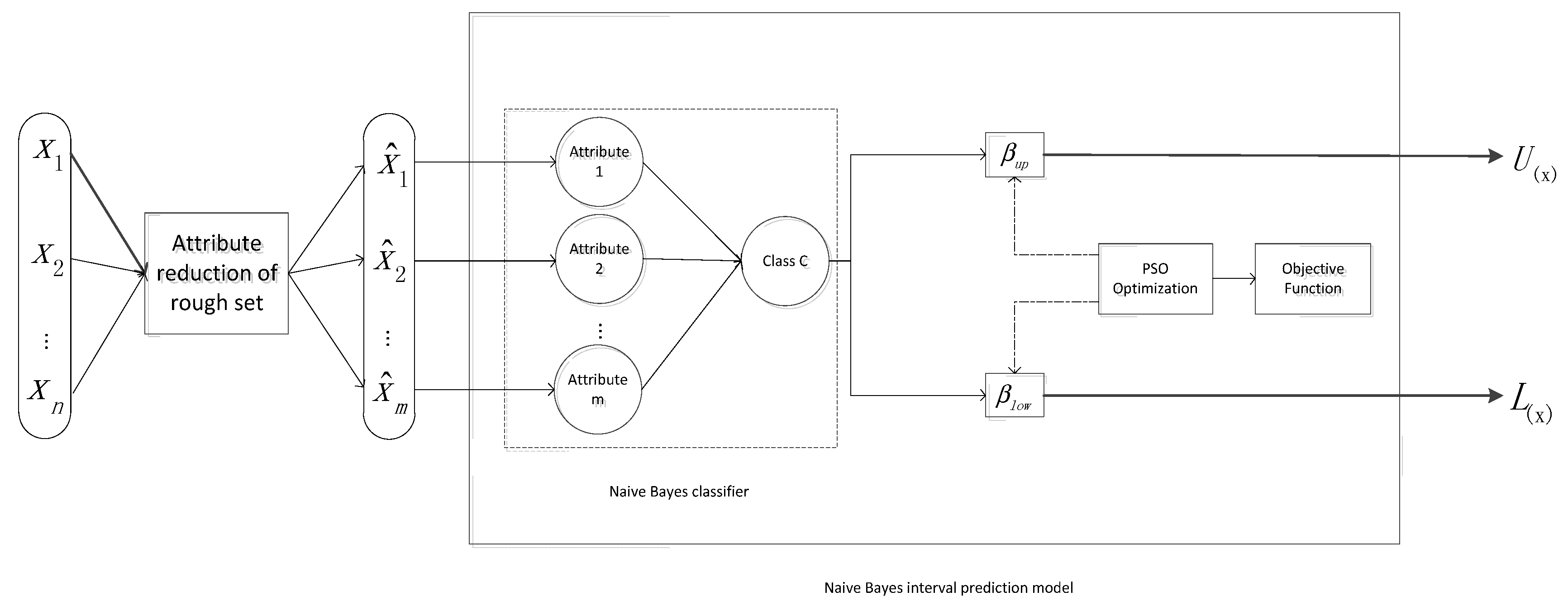
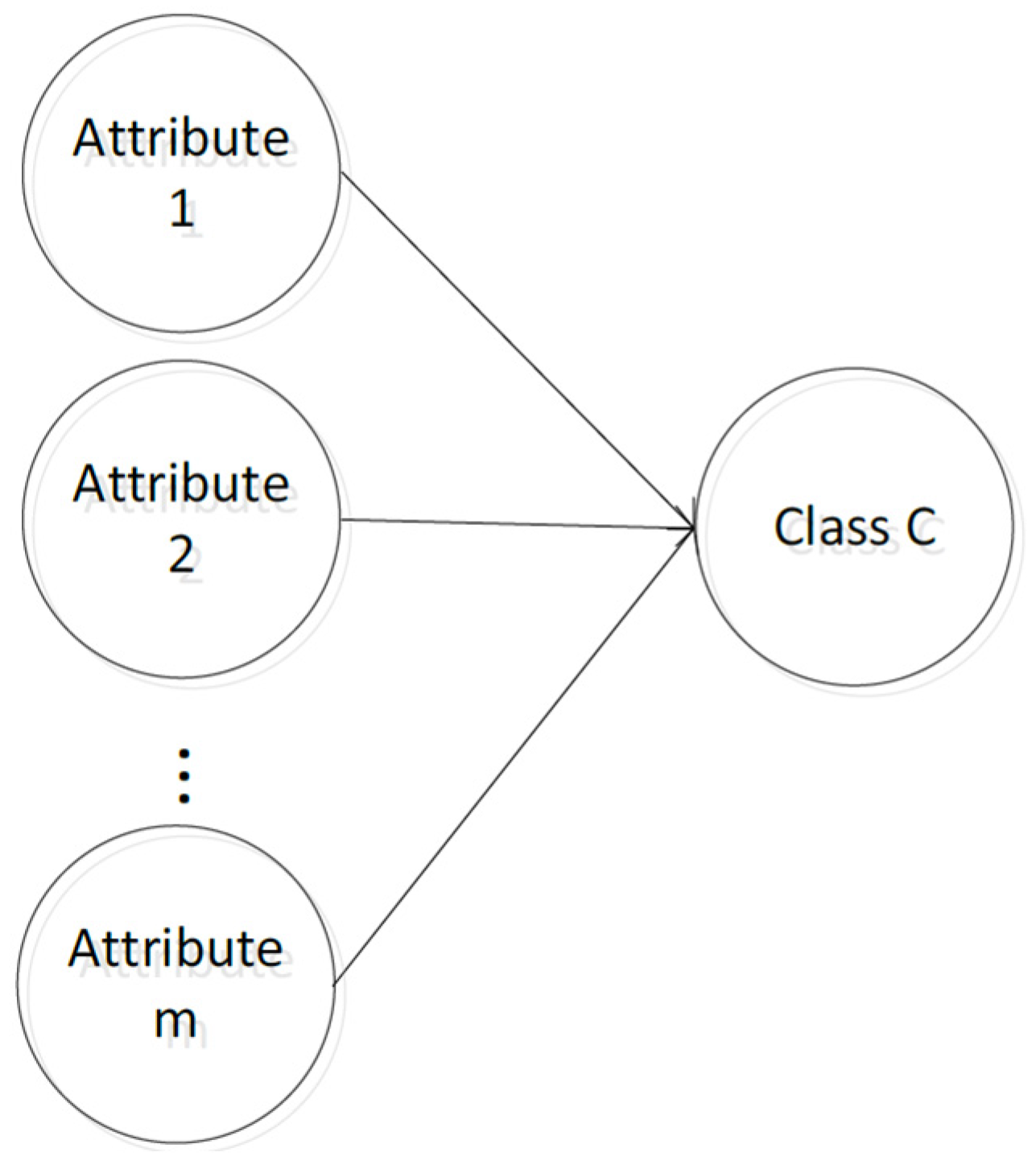
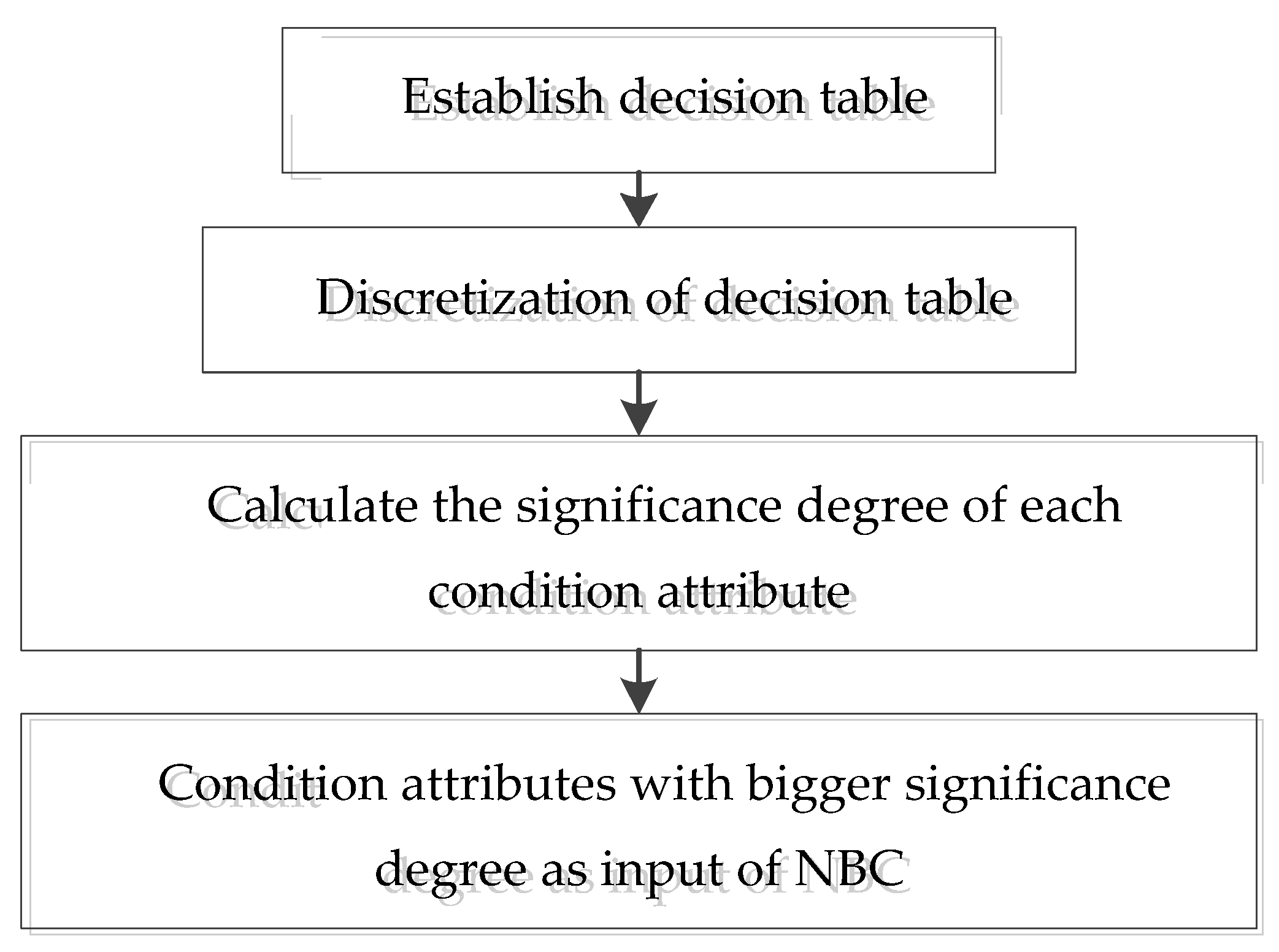
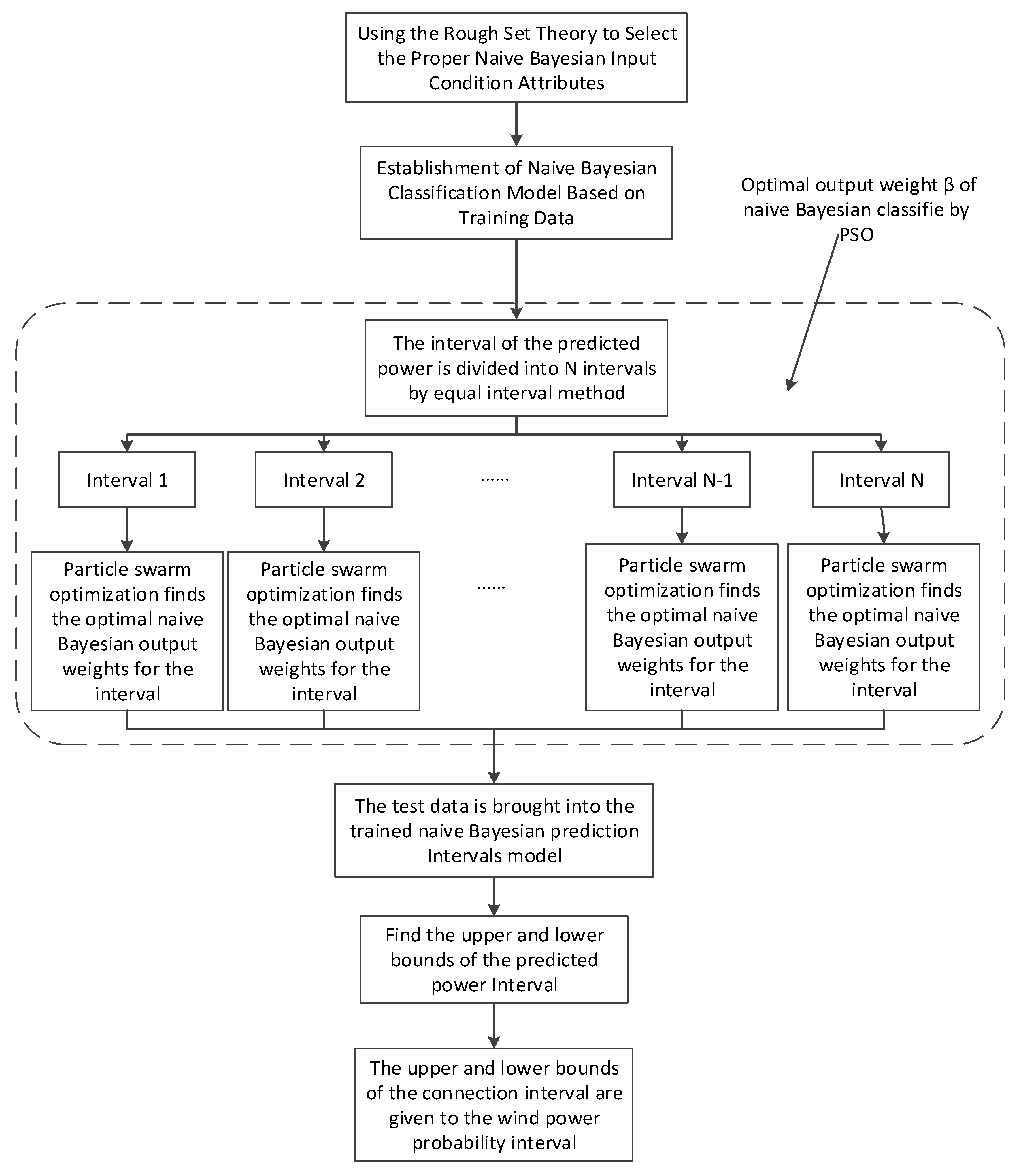
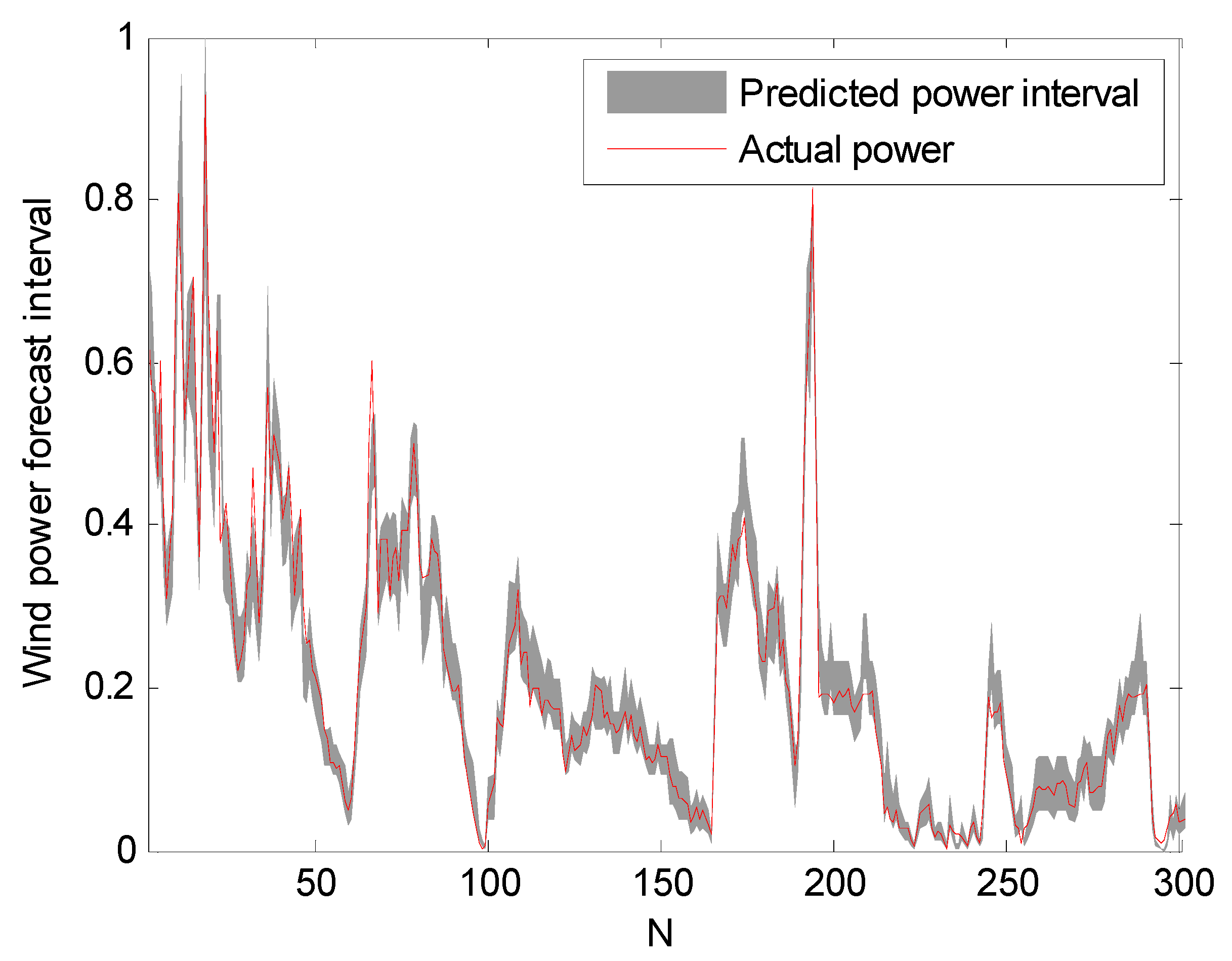
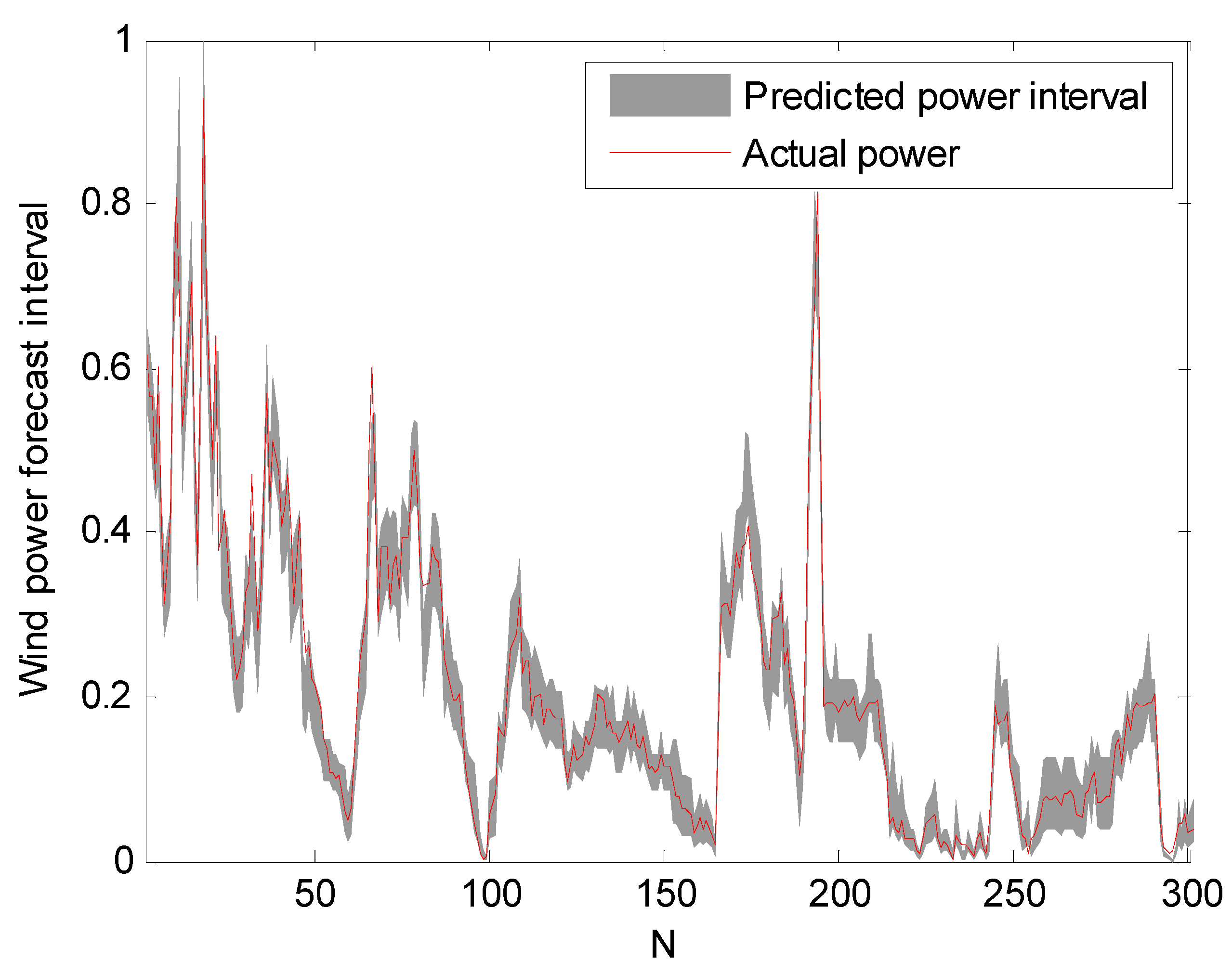
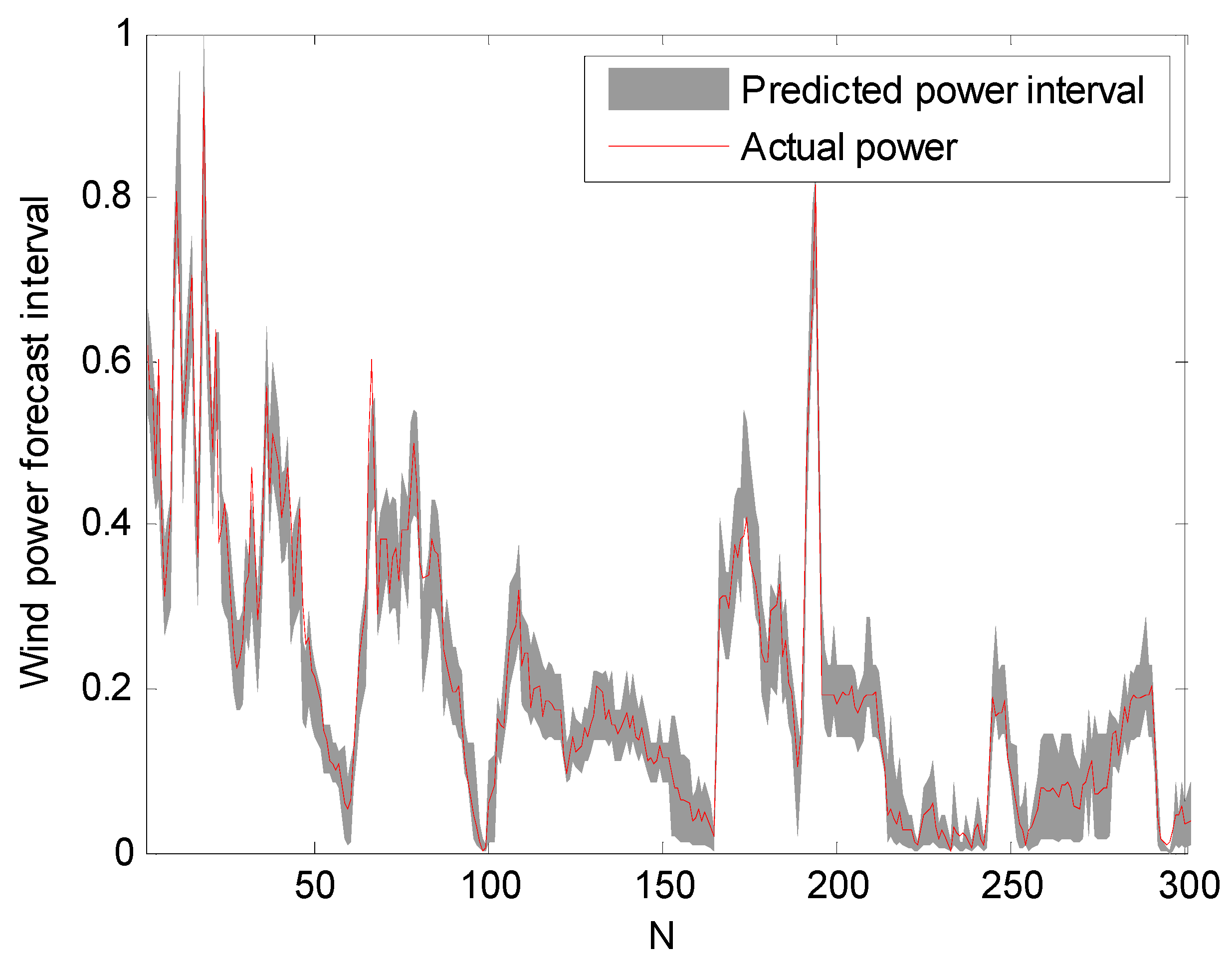
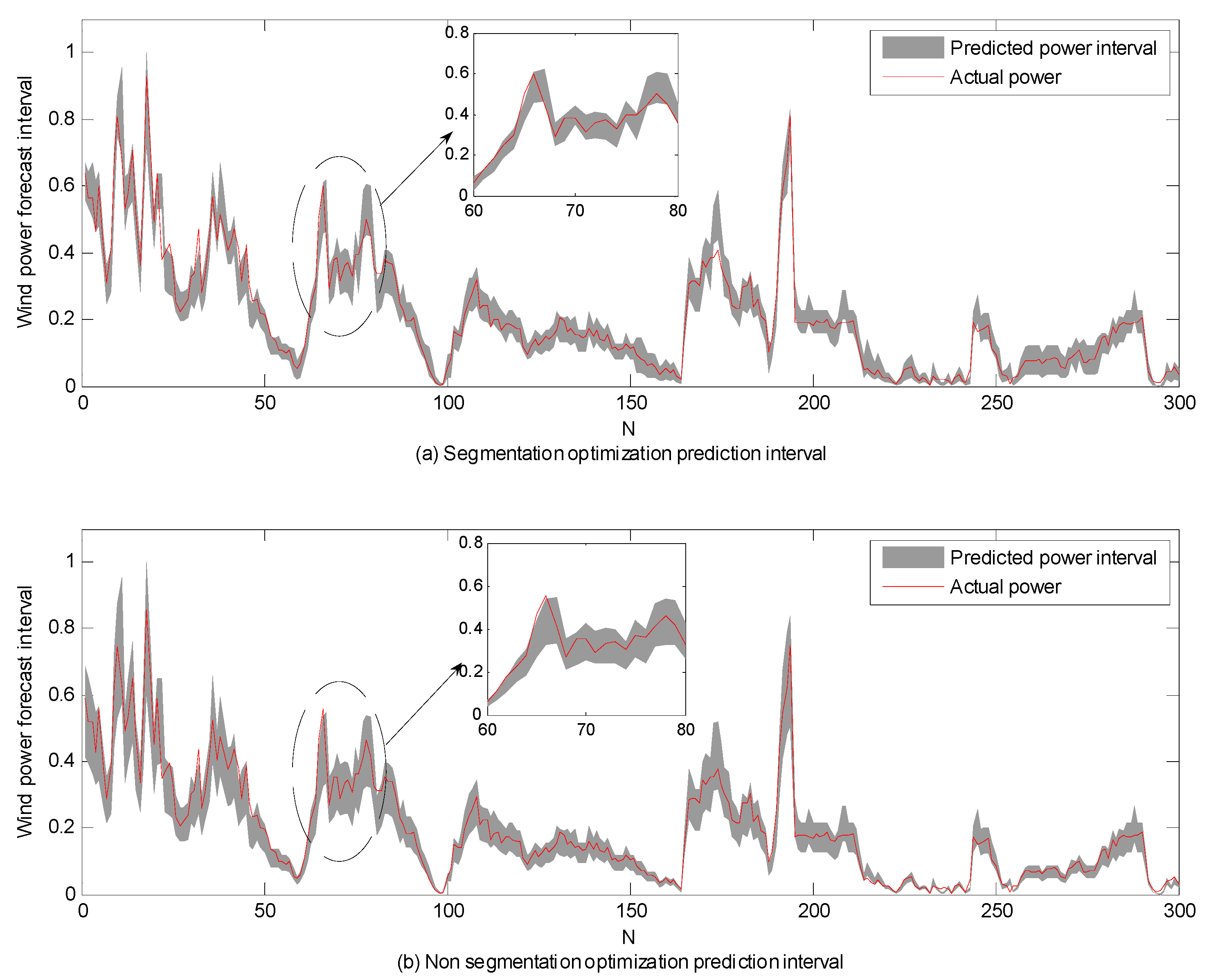
| Object | Condition Attribute | Decision Attribute | ||||||
|---|---|---|---|---|---|---|---|---|
| 1 | 5 | 3 | 5 | 7 | 3 | 10 | 5 | 3 |
| 2 | 6 | 5 | 6 | 3 | 8 | 18 | 9 | 6 |
| 3 | 4 | 5 | 4 | 9 | 6 | 7 | 5 | 4 |
| 11 | 10 | 14 | 19 | 6 | 7 | 10 | 14 | |
| 5 | 8 | 12 | 9 | 10 | 18 | 14 | 15 | 9 |
| 6 | 10 | 8 | 8 | 16 | 13 | 12 | 15 | 11 |
| Wind Speed | Wind Speed | Wind Speed | Power | Power | Power | Power |
|---|---|---|---|---|---|---|
| 0.2778 | 0.1333 | 0.1222 | 0.1889 | 0.1667 | 0.0667 | 0.0444 |
| 1 | 1.5922 | 0.4444 |
| 2 | 1.1994 | 0.7783 |
| 3 | 1.2241 | 0.8524 |
| 4 | 1.1370 | 0.8137 |
| 5 | 1.2439 | 0.9198 |
| 6 | 1.0971 | 0.8911 |
| 7 | 1.1475 | 0.9324 |
| 8 | 1.1355 | 0.9447 |
| 9 | 1.0187 | 0.8761 |
| 10 | 1.1016 | 0.8751 |
| Confidence Level/% | Method | PICP/% | PINAW |
|---|---|---|---|
| 80 | NBC | 79.56 | 237.3430 |
| RS-NBC | 80.22 | 217.4590 | |
| RS-PSO-NBC | 80.87 | 190.2462 | |
| 85 | NBC | 84.84 | 269.3378 |
| RS-NBC | 85.27 | 272.8840 | |
| RS-PSO-NBC | 85.51 | 228.8553 | |
| 90 | NBC | 89.67 | 307.1498 |
| RS-NBC | 90.33 | 296.1640 | |
| RS-PSO-NBC | 90.45 | 271.6239 |
© 2017 by the authors. Licensee MDPI, Basel, Switzerland. This article is an open access article distributed under the terms and conditions of the Creative Commons Attribution (CC BY) license (http://creativecommons.org/licenses/by/4.0/).
Share and Cite
Yang, X.; Fu, G.; Zhang, Y.; Kang, N.; Gao, F. A Naive Bayesian Wind Power Interval Prediction Approach Based on Rough Set Attribute Reduction and Weight Optimization. Energies 2017, 10, 1903. https://doi.org/10.3390/en10111903
Yang X, Fu G, Zhang Y, Kang N, Gao F. A Naive Bayesian Wind Power Interval Prediction Approach Based on Rough Set Attribute Reduction and Weight Optimization. Energies. 2017; 10(11):1903. https://doi.org/10.3390/en10111903
Chicago/Turabian StyleYang, Xiyun, Guo Fu, Yanfeng Zhang, Ning Kang, and Feng Gao. 2017. "A Naive Bayesian Wind Power Interval Prediction Approach Based on Rough Set Attribute Reduction and Weight Optimization" Energies 10, no. 11: 1903. https://doi.org/10.3390/en10111903
APA StyleYang, X., Fu, G., Zhang, Y., Kang, N., & Gao, F. (2017). A Naive Bayesian Wind Power Interval Prediction Approach Based on Rough Set Attribute Reduction and Weight Optimization. Energies, 10(11), 1903. https://doi.org/10.3390/en10111903




